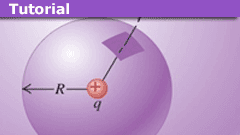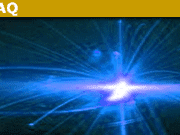Learn a Partial “Derivation” of Gauss’s Law
Gauss’s law was formulated by Carl Friedrich Gauss in 1835. It is one of the four Maxwell’s equations that form the basis of classical electrodynamics. Gauss’s law plays an important role because it reveals a simple relation between field and particle distribution. In the context of electrostatics, using Gauss’s law can greatly simplify the calculation of an electric field given a symmetric charge distribution. Therefore, it is both interesting and significant to look at the derivation of Gauss’s law. Here we will only be looking at the derivation of Gauss’s law applied to an electrostatic field, by showing its relation with Coulomb’s law.
Table of Contents
Gauss’s Law Formalism
Gauss’s Law can be expressed mathematically in integral form and differential form. They are equivalent and related by divergence theorem.
Integral Form: ∯S E·dA = Q/ε0
Differential Form: ∇·E = ρ/ε0
Gauss’s law is essentially equivalent to Coulomb’s law. Any “inverse-square law” can be formulated in a way similar to Gauss’s law.
Qualitative Derivation
In physics, many complicated problems start from some simple cases and then extend to general forms. We can utilize the idea to derive Gauss’s law. We will divide our problem into three parts, one more general than the other: point charge inside a spherical surface, point charge inside a non-spherical surface, and arbitrary charge distribution inside a non-spherical surface.
Point Charge Inside a Spherical Surface
In this step of our derivation, the fact that Gauss’s law is an alternative to Coulomb’s law can be quite valuable to us. When a point charge is placed at the center of an imaginary spherical surface(Gaussian Surface), the magnitude E of the electric field at every point on the surface is given by E = q/4πε0R2
At every point on the surface, E is perpendicular to the surface, and its magnitude is the same everywhere. So the total electric flux is just the product of the field Magnitude and the total surface area of the sphere:
ΦE = EA = (q/4πε0R2)·(4πR2) = q/ε0
which matches the form of Gauss’s law. We can begin to see why Gauss’s law is equivalent to Coulomb’s law.
Point Charge Inside a Non-spherical Surface
In this step, we need our previous conclusion as well as a projection technique. We start the same setting as in our previous step but add a non-spherical surface around the point charge. Now consider a small element of the area on the spherical surface, and then extend the radius to the non-spherical surface to obtain a small element of dA, as in graph(a). We note that dA is larger than the corresponding element on a spherical surface at the same distance from the point charge, as shown in graph(b). If E⊥ normal to dA makes an angle φ with the direction of electric field E, then dA projected onto the spherical surface same distance from q is foreshortened by a factor cosφ. So the electric flux through dA is given by:
ΦdA = E⊥dA = EdA′, dA′ is the area of the corresponding spherical area element.
We can divide the entire irregular surface into such area elements, and integrate them to sum the result. So the total electric flux through the irregular surface must be the same as total flux through a sphere, which is already derived in step 1: ΦE = ∮ E·dA = q/ε0.We now have derived Gauss’s law of a point charge in any shape of surface in a static field.
General Form
With all the work done, the final step is simple. If the surface enclosed not just one point charge q, but many charges q1, q2, q3, … . Then the total resultant electric field E at any point is the vector sum of the electric field of individual charges. We can perform the same analysis as in steps 1 and 2 for every charge, and sum up to get the total electric flux:
ΦE = ∮ E·dA = Qenc/ε0 ,
Qenc = q1 + q2 + q3 + …
Therefore, we have derived Gauss’s law: the total electric flux through a closed surface is equal to the total charge inside the surface divided by ε0.
Experimental Proof
The famous Faraday ice-pail experiment confirms the validity of Gauss’s law. More importantly, since Gauss’s law is an alternative to Coulomb’s law, Faraday’s experiment provides a more precise proof of the inverse-square relationship, because Coulomb’s experiment method, using a torsion balance and dividing of charges, is not very accurate.
The experiment goes that we mount a conducting container on an insulating stand. The container is initially uncharged. Then we hang a charged metal ball from an insulating thread, lower it into the container, and put the lid on. Charges are induced on the walls of the container, as in graph(b). But now we let the ball touch the inner wall (c). The surface of the ball becomes part of the cavity surface. If Gauss’s law is correct, then the net charge on the cavity surface must be zero. Thus the ball must lose all its charge. By withdrawing the ball from the container and verifying that it is uncharged and that the charge on the container is unchanged, we can verify Gauss’s law in the static field.
Summary
We have derived Gauss’s law by applying a commonly used method in physics: start from simple and extend to the general case. We’ve also seen experimental proof of Gauss’s law and its significance. The same analytical process can also be applied to Ampere’s law, another important equation of Maxwell’s four equations. However, note that we haven’t got a complete derivation of Gauss’s law here. We’ve proved Gauss’s law for charges inside a surface, but we have not discussed charges outside a surface. Also, Gauss’s law applies to all fields, not just time-invariant ones.
Reference
Currently a high school student, passionate about physics, especially areas of theoretical particle physics. Benefited a lot from study of physics MOOCs and great platforms like Physics Forums.





Does electricity have superimposed intelligence (wisdom)? Choosing pathway of least resistance? Might her decisions be better understood in viewing her as a simple relationship between field and wave distribution, for her period as a particle she is at rest as torsion field perpendicular to spinning black hole? As a wave seeking harmonic balance, adjustability …
Two thumbs up!
I am surprised you’re in high school. Nice. Congratulations.